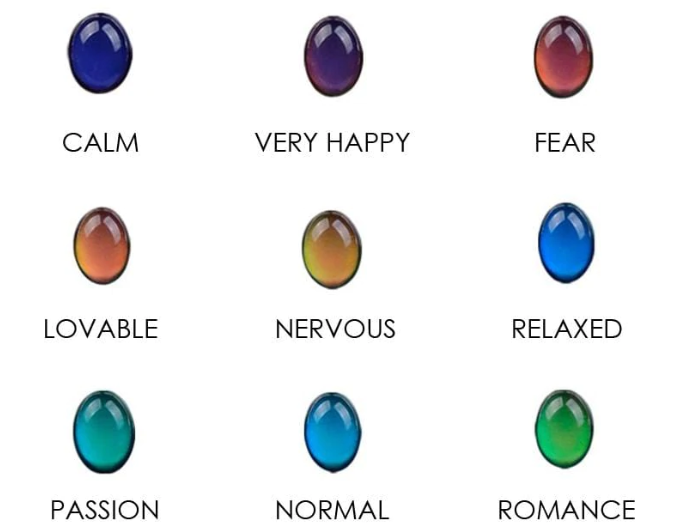Mood necklaces, fascinating bijoux that respond to subtle fluctuations in body temperature, often display a vibrant spectrum of colors. Among these chromatic shifts, purple holds a position of particular interest. Unraveling the significance of purple on a mood necklace requires an understanding of the thermochromic principles at play and the purported emotional states associated with each color. Let’s delve into what the appearance of purple purportedly signifies.
The Science Behind the Shift: A Primer on Thermochromism
Before decoding the emotional nuances of purple, grasping the underlying science is paramount. Mood jewelry typically employs thermochromic liquid crystals. These materials possess the unique ability to alter their molecular structure, and consequently their light absorption properties, in response to minute temperature variations. As body temperature fluctuates, these crystals twist and refract light differently, producing a kaleidoscope of colors. The color displayed directly correlates to a specific temperature range. Therefore, the interpretation of any color, including purple, is contingent on the calibrated temperature scale embedded within the necklace.
Purple: A Multifaceted Hue with Diverse Interpretations
Purple, a confluence of red and blue, often symbolizes a complex amalgamation of emotions. Historically, purple has been associated with royalty, nobility, and spirituality. These regal connotations imbue the color with an air of gravitas and mystique. However, within the context of a mood necklace, the interpretation can be more nuanced.
Common Interpretations of Purple on a Mood Necklace: A Comprehensive Overview
The specific emotional attribution to purple can vary, but several interpretations frequently surface:
- Relaxation and Tranquility: Purple often suggests a state of calmness and serenity. When a mood necklace displays purple, it may indicate that the wearer is experiencing a period of reduced stress and heightened equanimity. Perhaps the wearer is engaged in a meditative practice, enjoying a tranquil environment, or simply feeling at peace.
- Creativity and Intuition: Purple is frequently linked to imaginative thinking and heightened intuition. It can signify a state of creative flow, where ideas are readily generated and novel solutions emerge. This may indicate the wearer is engaged in artistic pursuits, brainstorming sessions, or problem-solving activities that require innovative thought processes.
- Spirituality and Mysticism: Given its historical association with spirituality, purple can denote a connection to one’s inner self or a sense of spiritual awareness. The wearer might be experiencing a profound sense of connectedness to something larger than themselves, engaging in spiritual practices, or exploring philosophical concepts.
- Sensuality and Passion: Depending on the specific shade of purple (leaning towards a reddish-purple, for instance), it can also represent sensuality and passion. This suggests a heightened state of romantic feelings, physical attraction, or an overall sense of vitality and zest for life.
- Ambivalence and Uncertainty: In some cases, particularly if the purple is a transitional color between blue and violet, it can indicate a state of ambivalence or uncertainty. The wearer may be grappling with conflicting emotions, undecided about a particular course of action, or feeling a sense of general unease.
Context Matters: Individual Variation and Environmental Influences
Interpreting the color purple, or any color on a mood necklace, requires consideration of individual physiology and environmental factors. Baseline body temperature varies from person to person. What appears as purple on one individual might manifest as blue or violet on another. Furthermore, external temperature significantly impacts the accuracy of the reading. In a cold environment, the necklace will naturally display cooler colors, potentially skewing the interpretation.
Beyond the Single Color: The Significance of Color Transitions
The transitions between colors on a mood necklace often provide more insightful information than any single color in isolation. A gradual shift from blue to purple, for example, might suggest a slow transition from a state of calm to a more creative or spiritual mindset. Conversely, a rapid fluctuation between colors could indicate emotional volatility or instability.
Limitations and Caveats: Treating Mood Necklaces with a Grain of Salt
While mood necklaces offer an intriguing glimpse into potential emotional states, it is crucial to acknowledge their limitations. They are not scientifically validated tools for accurately assessing mood. External factors, individual variations, and the inherent imprecision of thermochromic technology can all influence the displayed color. It is prudent to regard the colors as suggestive indicators rather than definitive pronouncements of emotional truth. Use mood necklaces as a conversation starter or a fun way to reflect on your feelings, but avoid relying on them for serious emotional self-assessment or diagnosis. Consider them novelties that add an element of whimsy to your day, reminding you to be mindful of your internal state without placing undue reliance on their color-coded pronouncements.







Leave a Comment